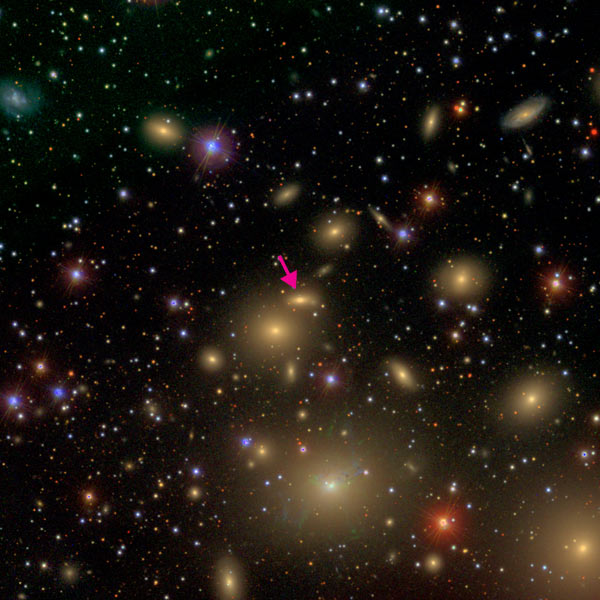







| BOOKS | F. A. Q. | ARTICLES | TALKS | ABOUT KEN | DONATE | BEYOND OUR KEN |
|---|
By Ken Croswell
Published on ScienceNOW (November 28, 2012)

Unlikely champion: NGC 1277 (arrow) is an unassuming member of the Perseus cluster, but it boasts an enormous black hole. Credit: D. W. Hogg, M. Blanton, and the SDSS Collaboration.
Imagine if the tallest skyscraper in Kalamazoo, Michigan, towered over any in New York City. That's akin to the puzzle confronting astronomers who have spotted one of the largest black holes ever found�anchoring a galaxy smaller than our Milky Way.
"This is totally not what I was looking for," says astronomer Remco van den Bosch of the Max Planck Institute for Astronomy in Heidelberg, Germany. "I was expecting to find really big black holes in really big galaxies."
Most large galaxies harbor giant black holes at their centers. The Milky Way's central black hole, for example, weighs 4 million times as much as the Sun. But such black holes usually obey a standard correlation: the heavier the galaxy's central bulge of stars, the heavier the black hole. In particular, the mass of a galaxy's bulge is about a thousand times that of its black hole.
But it seems that NGC 1277, a compact galaxy 230 million light-years away, never got the memo. Van den Bosch's team found that the stars near this galaxy's center are whirling around an enormous mass. As the researchers report in Nature, NGC 1277 sports a black hole that is 4000 times more massive than the Milky Way's and a whopping 17 billion times as massive as the Sun. In fact, more than half of the bulge mass of NGC 1277�59 percent�is in its black hole, far more than the expected 0.1 percent. If this black hole occupied the center of our solar system, it would engulf all the planets and extend nearly 10 times farther out than Pluto's orbit.
"It's a very simple result but extremely important, because this is a significant outlier," says astronomer Abraham Loeb of Harvard University. He believes the work is correct, for the black hole is so massive that its gravitational effects are easy to observe.
NGC 1277 belongs to a cluster of galaxies in the constellation Perseus and is a type common in clusters: the galaxy is a so-called lenticular galaxy, a cross between a spiral and an elliptical galaxy. Like a spiral galaxy, NGC 1277 has a disk of stars, but like an elliptical galaxy, it no longer gives birth to any more. NGC 1277 formed its last stars 8 billion years ago.
"Maybe this thing is a relic from way back when," van den Bosch speculates, noting that massive black holes powered brilliant quasars soon after the big bang. At that time, galaxies were small, but over the eons they grew larger by merging with other galaxies. Perhaps, van den Bosch says, NGC 1277 never grew up: it started with a big black hole but failed to attract lots of stars. Instead, its neighbors in the Perseus cluster may have grabbed the stars that would have given the galaxy greater luster.
Van den Bosch's team is studying five other compact galaxies to find out whether NGC 1277 is unique. "When you just have one very strange system, then you can almost always cook up some theories," says astronomer Chung-Pei Ma of the University of California, Berkeley. "But if these galaxies form a class of their own, then that would be quite exciting."
Ken Croswell earned his Ph.D. in astronomy from Harvard University and is the author of The Alchemy of the Heavens and The Lives of Stars.
"An engaging account of the continuing discovery of our Galaxy...wonderful." --Owen Gingerich, The New York Times Book Review. See all reviews of The Alchemy of the Heavens here.
"A stellar picture of what we know or guess about those distant lights."--Kirkus. See all reviews of The Lives of Stars here.
| BOOKS | F. A. Q. | ARTICLES | TALKS | ABOUT KEN | DONATE | BEYOND OUR KEN |
|---|